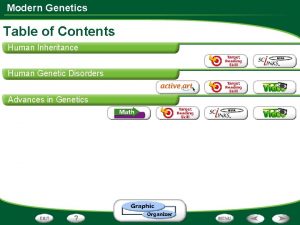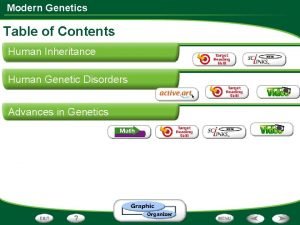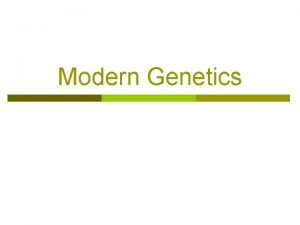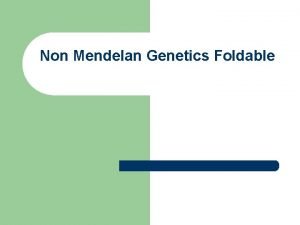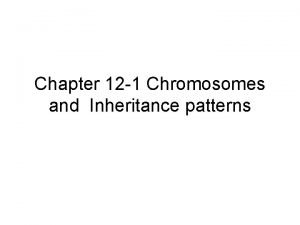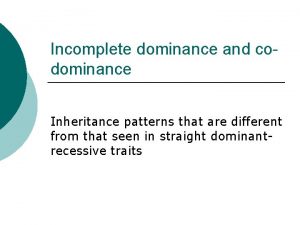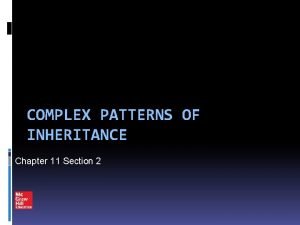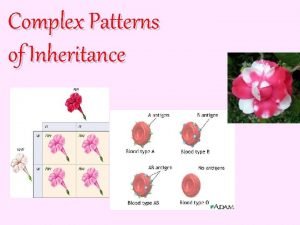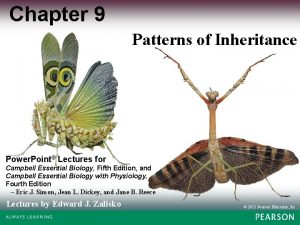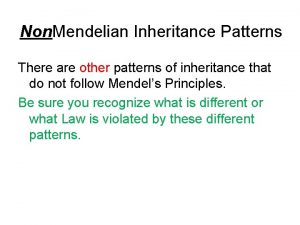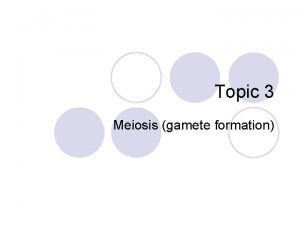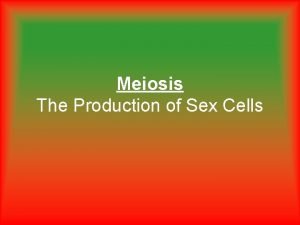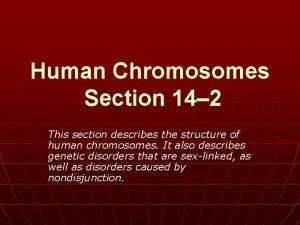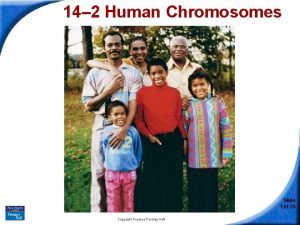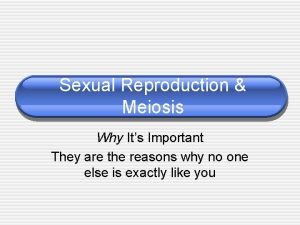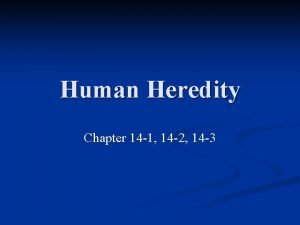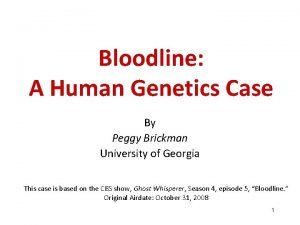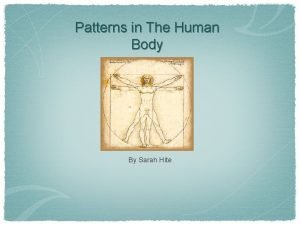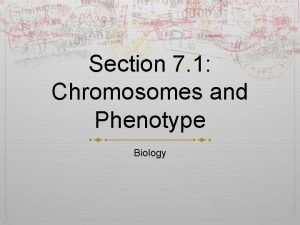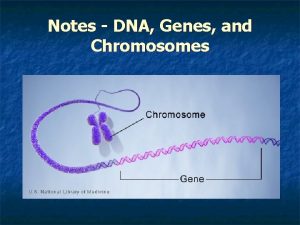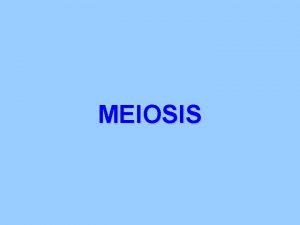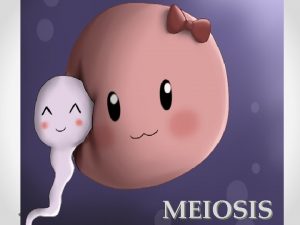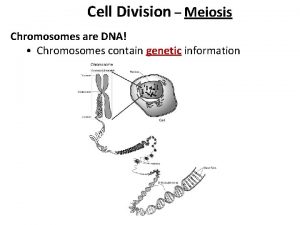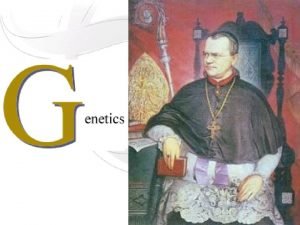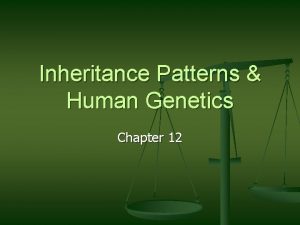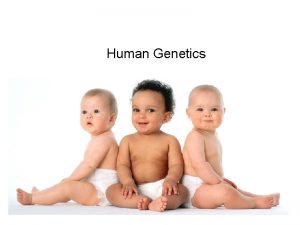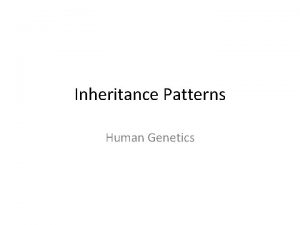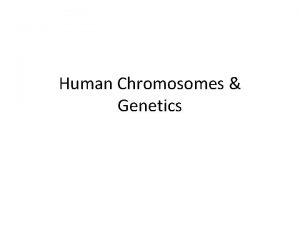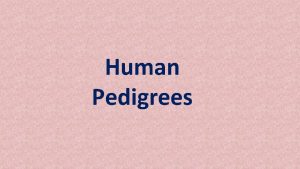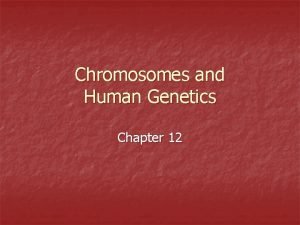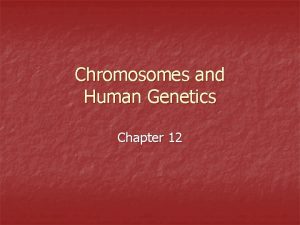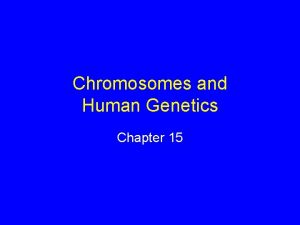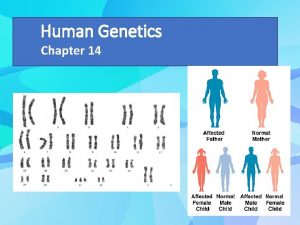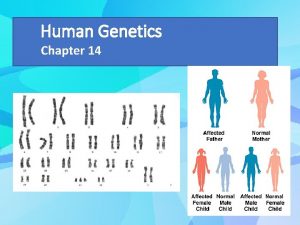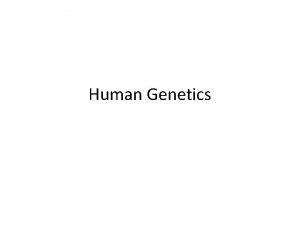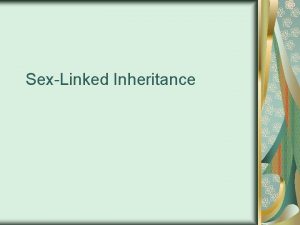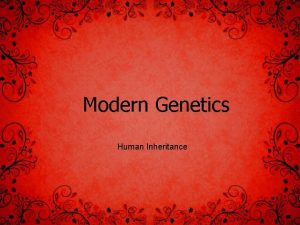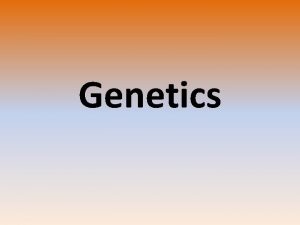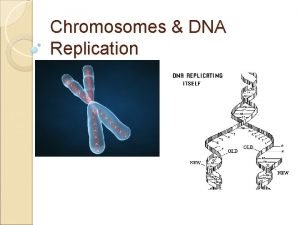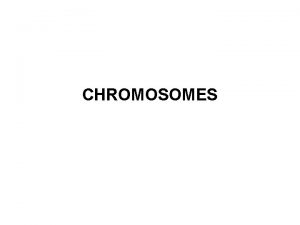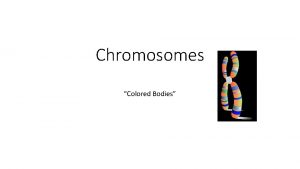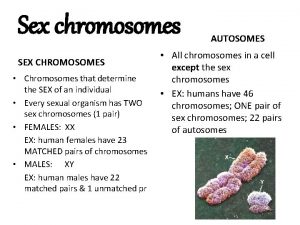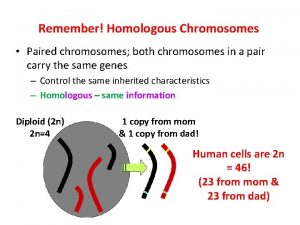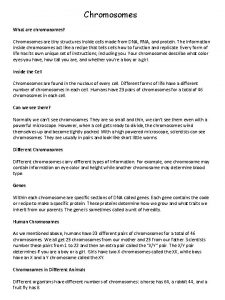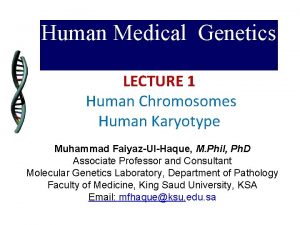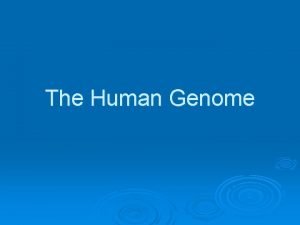Inheritance Patterns and Human Genetics Chromosomes and Inheritance



































- Slides: 35

Inheritance Patterns and Human Genetics Chromosomes and Inheritance

Objectives 1. Describe the sex chromosomes and sex linked genes. 2. Describe types of genetic mutations, where and how these mutations occur.

Chromosomes Early 1900’s – Thomas Hunt Morgan worked with Drosophila melanogaster (fruit flies) Found 4 pairs of chromosomes 3 pairs looked the same in males and females In females the 4 th pair looked identical to each other In males one of the 4 th pair looked like the female’s but the other was smaller Now we call these the x and y chromosomes

Human x and y chromosomes Notice that the y chromosome is 1/3 the size of the x chromosome

Sex Chromosomes and Autosomes Sex chromosomes hold genes that determine the gender of an individual. Autosomes are not directly involved in gender determination. Not all animals have sex chromosomes and some it is actually the reverse of humans Chicken and some moths are reverse Most fish and plants completely lack them

Sex Determination When gametes are formed there is a 50% chance that the sperm will have a y chromosome and a 50% chance it will be an x. There is a gene on the y chromosome that codes a protein for the formation of testes without this protein ovaries are formed.

Effects of Gene Location When T. H. Morgan and his team were studying Drosophila they found a male that had white eyes. When it was crossed with a normal female all F 1 offspring were red-eyed When F 2’s were crossed they got the 3: 1 ratio as expected but found only males had white eyes!

Sex-Linked Genes and Traits To explain the observations of Morgan’s team we look at a Punnett square between a homozygous redeyed female and a white-eyed male. Now cross the F 1 generation

Punnett Square of Homozygous Red. Eyed Female x White-Eyed Male XR XR Xr X RX r Y X RY This results in the F 1 generation. Notice that the females are heterozygous and that all offspring now have red eyes.

Punnett Square of Heterozygous Red. Eyed Female x Red-Eyed Male XR XR Y Xr X RX R X RX r X RY X r. Y F 2 generation genotypes: ¼ are female homoz. ¼ are female heteroz. ¼ males have red eyes ¼ males have white eyes The phenotype is ¾ with red eyes and ¼ white but the white are all male

Sex-Linked Genes and Traits This research showed that genes not only existed on c’somes but that eyecolor in fruit flies resided on the x c’some! Morgan called these sex-linked traits If they were on the X c’some they were X-linked If they were on the Y c’some they were Y-linked Most traits that are sex-linked traits are on the X c’some but show up most commonly in males because they are recessive and a female would have to be homoz. for the recessive trait

Mutations There are two basic types of mutations Germ-cell Mutations – do not affect the organism; are passed on to the offspring 2. Somatic-cell Mutations – occur in the body cells of the organism; not passed to offspring 1. Mutations can affect a whole c’some or just one nucleotide

Chromosome Mutations Deletion – part of the c’some breaks and is not reattached or a nucleotide is skipped Inversion – a segment of the c’some is flipped before it reattaches Translocation – part of the c’some breaks and is relocated to an unrelated c’some Duplication – a section of c’some is copied twice Nondisjuction – c’somes don’t separate during meiosis

Chromosome Mutations Deletion (A) Inversion (B) Translocation (C) Duplication (D)

Gene Mutations Point mutation: + or – of a single nucleotide Substitution: one base replace another, this could code for a different amino acid Frame shift: caused by a deletion mutation causing an incorrect grouping of codons left Insertion mutation: 1 or more nucleotides are added to the sequence, also may result in a frame shift.


Objectives: 1. Describe the inheritance patterns of humans. 2. Explain how pedigrees can be used to analyze inherited traits. 3. Describe how genetic disorders can be detected and treated.

Pedigrees Diagrams that show the inheritance of a particular trait over generations. Think of it as a family history. = Male Mating/marriage = Male with trait or disease = Female with trait or disease Offspring


Patterns of Inheritance Pedigrees are used to analyze patterns Autosomal traits will appear equally in males and females Sex-linked traits are usually only seen in males; they are mostly recessive If a trait is auto. dominate a parent will have the trait If a trait is auto. recessive one, both or neither parent will express the trait

Patterns of Inheritance continued Two individuals who are heterozygous for a trait can have a child with the trait Carriers are individuals who are heterozygous for a recessive trait The trait is not shown in them but they can pass it down to their offspring

Autosomal Recessive Pedigree

Autosomal Dominate Pedigree

Genetic Traits and Disorders Genetic disorders/diseases are any disease or disorder that has a genetic cause

Polygenic Inheritance Things like your blood type have only one gene that controls it, most genes in the human body are NOT like this! Polygenic characteristics are traits that are influenced by two or more genes. Skin color (3 to 6 genes that add together) Eye color Height Hair color

Complex Characters Traits that are influenced not only by the genome but also by the environment Height – proper nutrition and genetic potential Skin color – exposure to the sun and amount of melanin Cancer, diabetes, heart disease, stroke and schizophrenia Researchers hope to find the environmental risk factors to better educate people

Multiple Alleles Traits with 3 or more allele are said to be multiple alleles. Blood groups in humans demonstrate this Blood groups are also a good example of codominance. When both alleles are expressed

Incomplete Dominance When the heterozygous indv. expresses a blend of the two traits Snap dragons (shown) Straight hair x curly hair = wavy hair child

X-linked Traits Pedigrees will uncover these types of traits These are genes that are located on the X c’some Color blindness is one of the most well known

Single-Allele Traits HD can be traced back to two brother who migrated from England in the 1600’s More than 200 human traits are decided by one dominate allele Huntington’s disease Onset is about 30 -40 years old Starts with irritability and forgetfulness Progresses to muscle spasms, severe mental illness Ends in death DNA testing is allowing for earlier detection of the disease

Detecting Genetic Diseases Several ways to detect for diseases Pedigree looks at family history, may predict your genes by looking at your family history Blood tests Karyotypes Amniocentesis - way to detect diseases in the womb. Test for ~200 different genetic disorders in the fetus

Some Important Genetic Disorders Disorder/ gene symptoms Type of inheritance Frequency and pop HD Gradual deterioration, death Auto dom, c’some 4 1 in 10, 000 Cystic Fibrosis Mucus in lungs/pancreas; early adult Auto recess, c’some 7 1 in 900 French Ca; 1 in 2000 Europeans Sickle cell Organ damage due to impaired blood flow Auto recess, c’some 11 1 in 500 African Americans Tay-Sachs Breakdown of CN; live to ~age 3 Auto recess, c’some 15 1 in 600 Jews of European decent Phenyllketonuri a Brain fails to develop; child Auto recess, death c’some 12 1 in 18, 000 Americans Marfan Long limbs, loose joints, deformed spine, crowded teeth, rupture of arteries Auto dom, c’some 15 1 in 20, 000 Americans Breast Cancer Tumors in breast tissue Auto dom, c’some 17 ~ 8% of BC patients Hemophilia Ineffective blood clotting X-linked recess 1 in 7, 000

Genetic Counseling If a couple knows they have a history of a genetic disorder they can see a genetic counselor. Informs indvs of potential disease their offspring may have to contend with To get into this occupation you need to complete HS and have a bachelor’s degree with work in genetics, chemistry, statistics, psychology, developmental bio; MS degree in genetic counseling

Treating Genetic Diseases

Gene Therapy
 Human inheritance modern genetics answer key
Human inheritance modern genetics answer key Modern genetics human inheritance answer key
Modern genetics human inheritance answer key Modern genetics human inheritance answer key
Modern genetics human inheritance answer key Chapter 11 section 1 basic patterns of human inheritance
Chapter 11 section 1 basic patterns of human inheritance Chapter 11 section 1 basic patterns of human inheritance
Chapter 11 section 1 basic patterns of human inheritance Genetics foldable
Genetics foldable Section 12-1 chromosomes and inheritance
Section 12-1 chromosomes and inheritance Codominant inheritance patterns
Codominant inheritance patterns Complex patterns of inheritance
Complex patterns of inheritance Complex patterns of inheritance
Complex patterns of inheritance A gene locus is
A gene locus is Mendelian pattern of inheritance
Mendelian pattern of inheritance Chapter 9 patterns of inheritance
Chapter 9 patterns of inheritance Human genetics concepts and applications 10th edition
Human genetics concepts and applications 10th edition Mitosis division
Mitosis division How many chromosomes in human
How many chromosomes in human Nondisjunction in a sentence
Nondisjunction in a sentence 14-2 human chromosomes
14-2 human chromosomes 14-2 human chromosomes
14-2 human chromosomes How many chromosomes are in a human's sex cells
How many chromosomes are in a human's sex cells 14-2 human chromosomes
14-2 human chromosomes 14-3 human molecular genetics
14-3 human molecular genetics Bloodline a human genetics case answer key
Bloodline a human genetics case answer key Chapter 11 complex inheritance and human heredity test
Chapter 11 complex inheritance and human heredity test Closed patterns and max-patterns
Closed patterns and max-patterns Dating serves several important functions that include
Dating serves several important functions that include Patterns in the human body
Patterns in the human body Human needs and human development chapter 8
Human needs and human development chapter 8 Chapter 8 human needs and human development
Chapter 8 human needs and human development Non human nouns
Non human nouns Section 1 chromosomes and phenotype
Section 1 chromosomes and phenotype The relationship between genes dna and chromosomes
The relationship between genes dna and chromosomes Overvariation
Overvariation Diploid
Diploid Does meiosis occur in humans
Does meiosis occur in humans Chromosomes and alleles
Chromosomes and alleles
